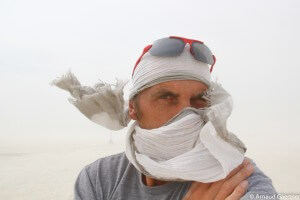Born in 1966 in Nancy, France.
Gaertner moved to Pennsylvania, US at the age of 3-6 (learned arnaud gaertnerto drink milk at school and sing the national anthem, never stopped!). He then spent 5 years in Rio de Janeiro, Brazil from age 10 to 16. Gaertner then travelled all over South America. He moved to Belgium for two years at the age of 16 and spent the next 12 years in in France. He took thousands of photos while traveling in North America, Asia Pacific, Europe, and the Middle East. He has resided in the Bay Area since 2012 with his wife Marine and their four sons. Gaertner is an explorer of California and its wonders.
Series “In the middle of nowhere”, 2014
In the middle of the Back Rock Desert, Nevada. In that Middle of Nowhere, 70 000 people camp in total autonomy for one week on a 30 million old dried lake, and on the main square, dozens, hundreds of art pieces, static or moving, are there, subject to the weather conditions: extreme heat, wind, dust storm. Most of the wooden art pieces are burned by the end of the week. As we speak all these moments are gone, people have left, art pieces returned into ashes, and I am glad these ephemeral moments are still alive through my photographs. This series is about the Ephemeral nature and Mystical dimension of the American desert.
Artist statement
By 16 years of age, I had already visited more than 30 countries and had lived abroad, away from my home country France, for close to10 years in the United States, Brazil and Belgium. This decade opened my eyes to the diversity of the world, seen through its landscapes, people, cultures, sounds and tastes. I love people. I love getting to know others better. I love trying to understand who people are and what it is that makes them who they are. I made my first pictures when my Dad let me borrow his old camera while we were discovering the world, then he bought me a Kodak with Cube Flashes-this was my first camera and I have never stopped taking pictures since then.
As an adult, I continue exploring all the continents. Photography keeps me connected to the magic of the planet. During my travels I have taken thousands of photos :f rom nature to cities, from diverse subjects to artists in their studios. This project, “In The Middle of Nowhere”, was born in the Black Rock Desert, Nevada, in September 2014. My son Baptiste had come to me and said “Dad, a friend of mine just came back from a crazy art festival in the desert called Burning Man”. Curious, we researched it and discovered something strange and amazing.
For my first time at Burning Man I stayed only 3 days, but I took over 3000 pictures! My camera lens ended up ull of dust, but that probably added to the mystery of my images and the “sense of nowhere” I felt deeply. In the middle of nowhere, under 100 degrees Fahrenheit, cycling on a lake that dried 30 million years ago, 70 000 people live in total autonomy for one week where no money is exchanged, and hundreds of art pieces, static or moving, under the heat, in a dust storm, are admired by visitors in very creative costumes. Everything is burned by the end of the festival in a ritual of true “Ephemeral Art!”
I seek to testify for the ephemeral, fleeting nature of these art pieces and unique moments made lasting by the photographic image. I try to capture the place, light, dusty wind that surround this eclectic eccentric happening. For this project I have selected about 30 im- ages out of 3000, helped by my two friends Gino Castoriano and Jules Maeght who are both gallerists. “In The Middle of Nowhere” is about people, places and art—those unique, ephemeral moments I capture through my images and that I want to share with you.
